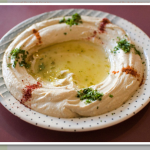 On various trips to the Middle East my family has debated the merits of hummus in all its glorious presentations and tastes. Sometimes it’s topped with zattar, other times with greens or a sprinkling of whole chickpeas. But the main dividing line always comes down to tahini: do you include a lot, or a little?
On various trips to the Middle East my family has debated the merits of hummus in all its glorious presentations and tastes. Sometimes it’s topped with zattar, other times with greens or a sprinkling of whole chickpeas. But the main dividing line always comes down to tahini: do you include a lot, or a little?
Even at home, we eat a lot of hummus. But after reading this article in Slate, I knew I had to stop buying it. How hard could it be to make hummus? I started to do some research. Turns out there are a lot of opinions about hummus, and people don’t just argue over how much tahini to use. Canned chickpeas or fresh? Paprika or cumin? Tahini or . . . . peanut butter? Really?
I considered my favorite recipe sites: allrecipes.com, mideastfood.com, Ina Garten on the Food Network. But I ended up going with a recipe I found on the Hummus Blog, an easygoing (if opinionated) blog with the slogan “Give chickpeas a chance . . .” If you are using dried chickpeas ($2.49 a pound at Fairway for organic chickpeas) the recipe includes a lot of cranky details, like suggestions to change the cooking water midway through the cooking. As with many legumes, you need to soak and rinse dried chickpeas to get rid of undigestible sugars.
But it’s worth using dried chickpeas – they taste delicious. Eventually. I soaked my chickpeas overnight, then changed the water and soaked them some more. I cooked them for an hour and a half in fresh water with baking soda (I forgot to add it when I soaked them overnight). And then I went out to buy tahini.
“This one’s the best!” the man at Damascus Bakery (195 Atlantic Avenue) told me cheerily, handing me a jar of Al Wadi tahini from Lebanon ($4.75 for a pound, shake the jar before you use the tahini). He rolled his eyes when I told him what I was making. I used Celtic sea salt I bought at the Brooklyn Foodshed (sorry, it was a couple of months ago, I forget how much it cost). I stirred in about two tablespoons of tahini (we are of the less tahini is better school). And I didn’t have a lemon, but I did have half a lime, so I used that. I added garlic and cumin. And after a couple of practice runs, I learned two useful lessons. Put the garlic in the food processor with the cooked chickpeas, so it’s evenly distributed. And add quite a lot of the cooking water, counterintuitive though that seems. The chickpeas soak it right up.
We topped it with za’atar (available at Damascus Bakery, or you can make your own) and olive oil. The bottom line? It’s delicious.
Picture source: jcarrot.org
Update March 1: Before I posted originally I did some inconclusive research on the baking soda issue, which is why I didn’t address it. According to both The Hummus Blog and a food scientist, it helps to soften the chickpeas to the right consistency. For more of the science behind hummus, like whether it’s worth waiting for the cooked chickpeas to cool before you mash them (it is!) see this article.
